Archive Record
Images
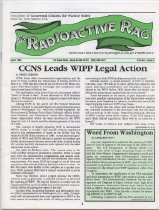
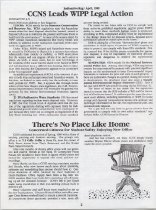
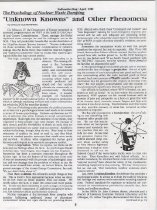
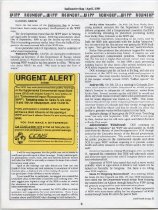

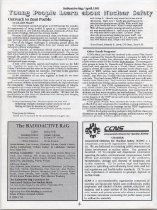
Additional Images [6]

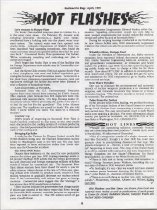
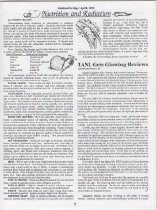
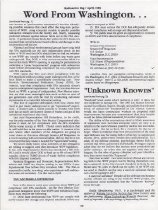
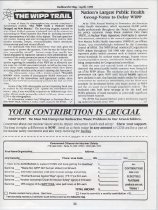
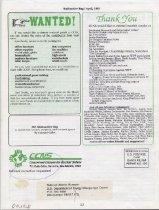
Metadata
Catalog Number |
00.18.5 |
Object Name |
Newsletter |
Scope & Content |
The Radioactive Rag, Newsletter of Concerned Citizens for Nuclear Safety, Santa Fe, New Mexico USA, Vol. 1, Issue 2, April 1989. Articles: CCNS Leads WIPP Legal Action. Word from Washington. The psychology of nuclear waste dumping: "Unknown knowns" and other phenomena. Los Alamos get "glowing" reviews. Young people learn about nuclear safety. Editorial: The Land of Entrashment. Nutrition and radiation. Nation's largest public health group votes to delay WIPP. Los Alamos get "glowing" reviews: The recent television movie "Day One" was hailed as the definitive history of Los Alamos lab and the atomic bomb. It disclosed that even after the war was clearly won, scientists at the country's largest ever scientific project could not stop themselves from working on these fascinating technical problems. There were great uncertainty about whether the bomb would explode, and if it did, what would happen. There was an outside chance that the atmosphere of the world would be rendered critical and the earth enveloped in fire. The decision was made to proceed with detonation. As quoted in Helen Caldicott's Missile Envy, one junior technician was astonished to hear the brilliant physicist Enrico Fermi taking side bets, as the Gadget was hoisted to the top of its tower, that "New Mexico would be incinerated." To show Congress that the money hadn't been wasted, the bomb was dropped on a civilian population. U.S. military forces sent to clean up Hiroshima and Nagasaki are now members of the National Association of Radiation Survivors suffering from a myriad of health problems the government refuses to correlate to radiation exposures. Los Alamos, the most super-secret nuclear facility in the country, is the "first-born male child" of the weapons complex. Los Alamos National Lab (LANL) and Livermore Labs are financed and operated by the Department of Energy under the academic sponsorship of the University of California. This convenient arrangements gives them a degree of independence and neutrality. These labs have designed every nuclear weapon in the US arsenal. LANL operates on a budget of $21 million annually with 7,018 employees. There is a rivalry between the 2 labs-deliberate government policy to ensure better bombs. LANL has designed 2/3 of the weapons in the nuclear stockpile, including hydrogen bombs for air and submarine-launched cruise missiles. One dissenting physicist, Hugh DeWitt at Livermore, calls the labs "repositories of hawkish views of the world, distrust of the Russians, faith in high technology to provide protection and strong opposition to any measures that might limit nuclear weapons development." With access to classified information and extremely powerful influence within government circles, the labs have opposed all suggested nuclear arms cutbacks and test-ban treaties. Historically, LANL shares the abysmal track record that is now being revealed about the entire DOE. In the race to build the bomb no waste burial records were kept from 1944-48. These areas were left unattended for the next 30 years. Today, vegetation above the site contains a radical range of radioactivity. From 1944-1964, untreated radioactive liquid wastes were dumped into Acid-Pueblo Canyon. In 1976 an "operational error" in the Cryogenics Building allowed 22,00 curies of tritium gas to escape through a vent. In 1977, an estimated 30,800 curies of tritium were accidentally released to the atmosphere as a result of a loose fitting. LANL has 14 known solid waste sites, storing radioactive waste in pits, trenches and shafts. Many kinds of radioactivity are handled there, including transuranics, low-level waste, mixed fission products, uranium and tritium. The substances are mixed with flammable materials, although the lab replaces the word flammable with combustible. In 1980, the New Mexico Tumor Registry showed that Los Alamos County residents had breast and digestive tract cancer at twice the national average. The question becomes how much radiation is allowable for optimum human health. The bomb and LANL are 46 years old; like anyone in a mid-life crisis, all past excess and denial must be paid for in preparing for a healthy old age. It's clean-up time and bad habits in the nuclear industry must be eradicated. We do not want to wake up in shock like the citizens in Fernald. New Mexicans do not want to be the next victims of National Security. Nutrition and Radiation: Needless to say, a "fast food" diet, full of refined, processed, denatured, high-fat, high-sodium, high-sugar, low-fiber foods only serves to deplete the protective vitamins and minerals and compromise our basic constitution. Never in the course of history has the physical body been under such an incredible assault, including radiation, toxic chemicals, heavy metals, air and water pollution, pesticides, noise, light and electromagnetic excess. As we now witnessing the decline of the immune system, it is more important than ever to practice protective nutrition. A healthy diet is becoming a key to enjoyable survival. A documentary entitled, "The WIPP Trail: a Nation's Crisis Dumped on New Mexico." The hour-long program narrated by Robert Redford can be ordered for $25 through CCNS. 8.5 x 11", 12 pages. |
Creator |
Concerned Citizens for Nuclear Safety |
Title |
The Radioactive Rag; Vol. 1, Issue 2; April, 1989 |
Collection |
Betty Sumpter |
Lexicon category |
8: Communication Artifact |
Lexicon sub-category |
Documentary Artifact |
